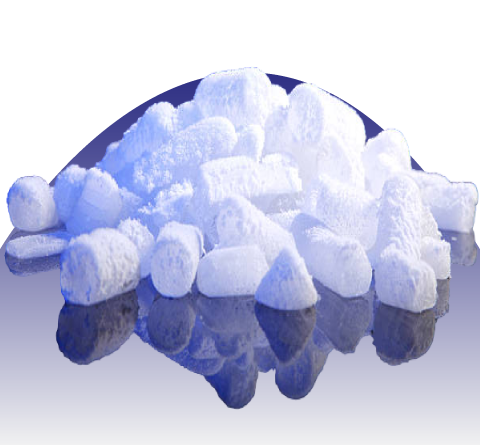Dry Ice
Solid State Carbon Dioxide

Dry Ice
Dry ice, also known as solid carbon dioxide, is a form of carbon dioxide that is in a solid state at temperatures below -109.3°F (-78.5°C). It is a colorless, odorless, and non-toxic solid that sublimates (changes from a solid to a gas) at room temperature.
Properties
- Dry ice is extremely cold, with a temperature of -109.3°F (-78.5°C)
It sublimates at room temperature, meaning it changes from a solid to a gas without going through a liquid phase.
It is non-flammable and non-toxic, but it can be harmful if inhaled in large quantities.
Applications
Dry ice is commonly used as a refrigerant for shipping perishable goods, such as food and medical supplies.
It is also used in the entertainment industry, to create smoke and fog effects.
It is used in the cleaning and surface preparation industry, for cleaning and removing coatings from surfaces.
It is also used in the oil and gas industry, for well stimulation and pipeline cleaning.
Dry ice is also used in the medical field, for cryosurgery, the treatment of warts, skin tags and other benign growths by freezing them with the dry ice.
Handling and storage:
Dry ice should be handled with gloves or tongs, as it can cause frostbite if it comes into contact with the skin.
It should be stored in insulated containers, as it sublimates at room temperature.
Dry ice should be transported in well-ventilated areas, as it produces carbon dioxide gas as it sublimates, which can be harmful if inhaled in large quantities.
As with any substance, it is important to handle dry ice with care and in accordance with the proper safety guidelines, to ensure the safety of the workers and the surrounding environment.
Dry Ice
Dry ice, also known as solid carbon dioxide, is a form of carbon dioxide that is in a solid state at temperatures below -109.3°F (-78.5°C). It is a colorless, odorless, and non-toxic solid that sublimates (changes from a solid to a gas) at room temperature.
Properties:
- Dry ice is extremely cold, with a temperature of -109.3°F (-78.5°C)
It sublimates at room temperature, meaning it changes from a solid to a gas without going through a liquid phase.
It is non-flammable and non-toxic, but it can be harmful if inhaled in large quantities.
Applications
Dry ice is commonly used as a refrigerant for shipping perishable goods, such as food and medical supplies.
It is also used in the entertainment industry, to create smoke and fog effects.
It is used in the cleaning and surface preparation industry, for cleaning and removing coatings from surfaces.
It is also used in the oil and gas industry, for well stimulation and pipeline cleaning.
Dry ice is also used in the medical field, for cryosurgery, the treatment of warts, skin tags and other benign growths by freezing them with the dry ice.
Handling and storage:
Dry ice should be handled with gloves or tongs, as it can cause frostbite if it comes into contact with the skin.
It should be stored in insulated containers, as it sublimates at room temperature.
Dry ice should be transported in well-ventilated areas, as it produces carbon dioxide gas as it sublimates, which can be harmful if inhaled in large quantities.
As with any substance, it is important to handle dry ice with care and in accordance with the proper safety guidelines, to ensure the safety of the workers and the surrounding environment.
Kindly Note
As with any gas, it is important to handle Dry Ice with care and in accordance with the proper safety guidelines, to ensure the safety of the workers and the surrounding environment.